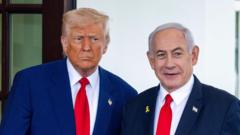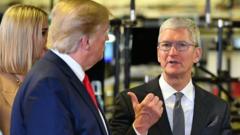As the trade landscape shifts, both nations continue discussions while managing tensions over tariffs and bilateral trade flows.
Trade Truce Extended: US and China Postpone Tariff Hikes Until November

Trade Truce Extended: US and China Postpone Tariff Hikes Until November
The US and China mutually agree to push back tariff increases, offering temporary relief amid ongoing negotiations.
In a significant diplomatic maneuver, the United States and China have agreed to extend their trade truce for an additional 90 days, just hours before a scheduled increase in tariffs was set to take effect. This decision, announced following an executive order signed by President Trump, maintains the pause on certain tariffs that was agreed upon back in May.
The development comes in the wake of concerns that the reintroduction of higher tariffs could have exacerbated existing tensions and contributed to economic uncertainty. Officials from both countries labeled last month's negotiations as "constructive," indicating a desire to uphold the truce. Following these discussions, China's chief negotiator expressed optimism about the stability of trade relations, while U.S. representatives remained hopeful for final agreements pending Trump’s approval.
The backdrop of these negotiations is a history marked by escalating trade tensions that began in earnest earlier this year, when President Trump announced broad new tariffs on various import categories, prominently affecting Chinese goods. Beijing retaliated in kind, amplifying tariffs in a move that plunged both economies into a retaliatory trade war, with impact felt widely across the global market.
Under the current terms, Chinese imports to the U.S. face an elevated tariff of 30% compared to the beginning of the year, alongside a 10% tariff on American products entering China. Despite the extension, the trade dynamics remain strained, with discussions ongoing regarding vital topics like access to rare earth materials, energy purchases from Russia, and technology transfer limitations.
Recently, the U.S. relaxed some technology export restrictions, permitting certain companies like AMD and Nvidia to resume selling chips to China under new revenue-sharing guidelines. Additionally, the contentious issue of TikTok's ownership persists, with the U.S. advocating for a restructuring of its operations separate from its Chinese parent company, ByteDance.
Despite the temporary truce, statistical reports have revealed stark reductions in trade volume between the U.S. and China, highlighting a drastic drop in U.S. imports from China in June 2024. The January-to-June period saw total imports from China decrease by approximately 15% year-on-year. Meanwhile, U.S. exports experienced a 20% decline in the same timeframe, reflecting the ongoing challenges within this critical bilateral relationship.
The development comes in the wake of concerns that the reintroduction of higher tariffs could have exacerbated existing tensions and contributed to economic uncertainty. Officials from both countries labeled last month's negotiations as "constructive," indicating a desire to uphold the truce. Following these discussions, China's chief negotiator expressed optimism about the stability of trade relations, while U.S. representatives remained hopeful for final agreements pending Trump’s approval.
The backdrop of these negotiations is a history marked by escalating trade tensions that began in earnest earlier this year, when President Trump announced broad new tariffs on various import categories, prominently affecting Chinese goods. Beijing retaliated in kind, amplifying tariffs in a move that plunged both economies into a retaliatory trade war, with impact felt widely across the global market.
Under the current terms, Chinese imports to the U.S. face an elevated tariff of 30% compared to the beginning of the year, alongside a 10% tariff on American products entering China. Despite the extension, the trade dynamics remain strained, with discussions ongoing regarding vital topics like access to rare earth materials, energy purchases from Russia, and technology transfer limitations.
Recently, the U.S. relaxed some technology export restrictions, permitting certain companies like AMD and Nvidia to resume selling chips to China under new revenue-sharing guidelines. Additionally, the contentious issue of TikTok's ownership persists, with the U.S. advocating for a restructuring of its operations separate from its Chinese parent company, ByteDance.
Despite the temporary truce, statistical reports have revealed stark reductions in trade volume between the U.S. and China, highlighting a drastic drop in U.S. imports from China in June 2024. The January-to-June period saw total imports from China decrease by approximately 15% year-on-year. Meanwhile, U.S. exports experienced a 20% decline in the same timeframe, reflecting the ongoing challenges within this critical bilateral relationship.





















